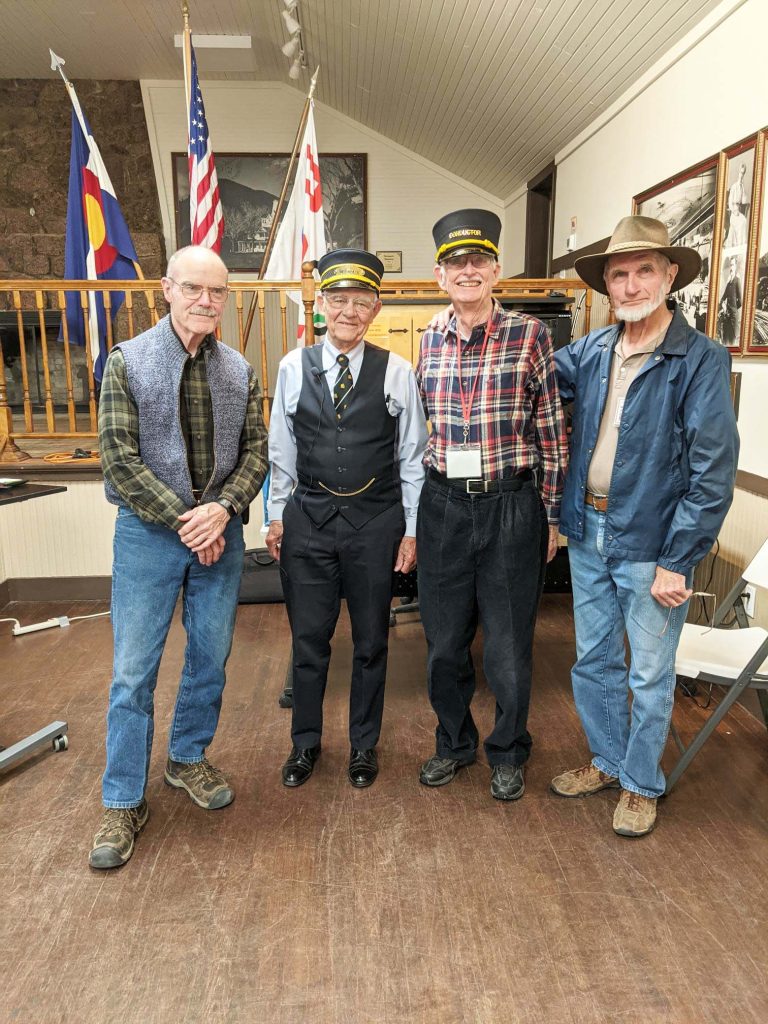By Marlene Brown
The Palmer Lake Historical Society (PLHS) April meeting hosted John Haney, a founding member of the Pikes Peak Trolley Museum and Restoration Shop. He has co-written three books on the history of streetcars and trolley systems. Haney’s talk centered on the streetcar system in Colorado Springs and Manitou Springs. He is a native of Colorado Springs and his family has been here since the1890s.
Beginning in 1887, streetcars were pulled by horses. Called horsecars, they traveled along Tejon Street and Cascade Avenue, stopping at the restaurants and saloons in the new city of Colorado Springs. They would go to the north end to the 1888 Rock Island Roundhouse in the community of Roswell to turn around. This building is just west of Cascade near Penrose Hospital. The Roundhouse is now being operated by the Pikes Peak Street Railway Foundation for the Trolley Museum and Restoration Shop. For more information, see www.coloradospringstrolleys.com.
By 1900 came the electric trolley cars. The electric trolley line was called the “Colorado Springs Rapid Transit Railway Co.” The trolleys could go 20 miles per hour. On South Tejon, near Las Animas Street and Sierra Madre, there was a building called the Car Barn. Starting 1906, this is where the maintenance and the building of new streetcars were done. There are still remnants of the buildings used, and some of the buildings are occupied today.
Traveling roundtrip to Manitou Springs began at the Santa Fe Train Depot on Pikes Peak Avenue. It traveled west on Colorado Avenue though Old Colorado City to the Loop. The Loop was built to turn around the cars to return on the route. The Loop is located at the intersection of Ruxton and Manitou Avenues where the restaurant, The Loop, is located.
The trolleys ran in the Springs until 1932. By then, most people owned an automobile and then came the beginning of the Great Depression, when people did not have money to ride the trolleys. Many of the streetcars were dismantled during WWII for metal parts. Some the cars were sold and became cottages and shops. Many are still around today.
There has been an interest in bringing trolleys back in the Springs. The intent by the museum foundation and volunteers is to preserve and maintain historic and vintage trolleys and the Roundhouse for future street railway operations. See www.coloradospringstrolleys.com/overview.
**********
PLHS meetings are usually held on the third Thursday of the month at Palmer Lake Town Hall, 42 Valley Crescent, Palmer Lake. The next meeting will be held May 16, 7-8 p.m. (doors open at 6:30 p.m.). Gail Beaton will be portraying “Gail Murphy: Colorado’s Rosie the Riveter.”
For more information on this and future presentations and membership to PLHS, go to www.palmerdividehistory.org.
Marlene Brown can be reached at marlenebrown@ocn.me.

Other Palmer Lake Historical Society (PLHS) columns
- Palmer Lake Historical Society, July 19 – The power of print (7/31/2025)
- Palmer Lake Historical Society, June 15 – Father’s Day Ice Cream Social (7/3/2025)
- Palmer Lake Historical Society, May 15 – Author recounts life of Nikola Tesla (6/7/2025)
- Palmer Lake Historical Society, April 17 – Women of the Colorado gold rush era (5/3/2025)
- Palmer Lake Historical Society, April 21 – General Palmer’s life explored (4/5/2025)
- Palmer Lake Historical Society, Jan. 16 – 2024 events recalled (2/1/2025)
- Palmer Lake Historical Society, Dec. 19 – Palmer Lake holds 91st annual Yule Log Hunt (1/4/2025)
- Palmer Lake Historical Society, Nov. 21 – Life of town hero explored (12/5/2024)
- Palmer Lake Historical Society, Oct. 17 – How the star and Town Hall became historic places (11/2/2024)
- Palmer Lake Historical Society, Sep. 19 – Author focuses on Old West (10/5/2024)
